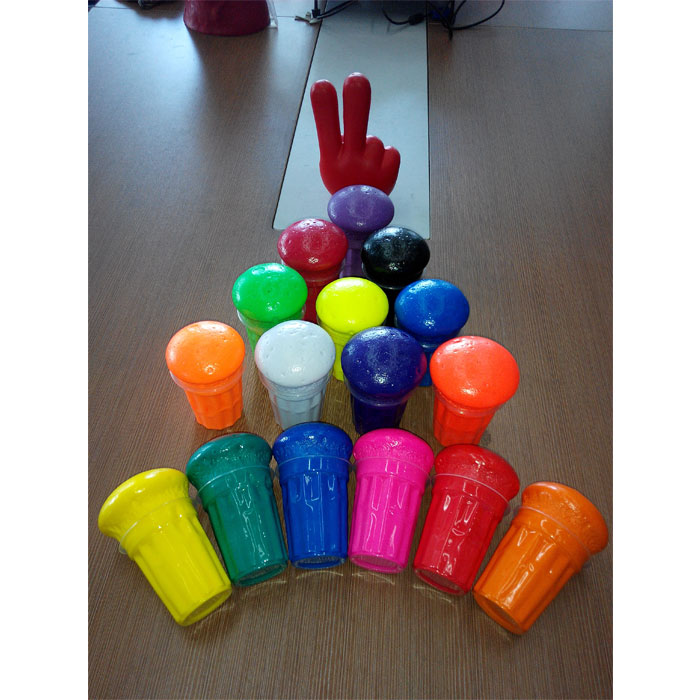Poliuretan elastomer formed by the polymerization reaction of diisocyanate and active hydrogen compound, the rigid segment containing urea group composed of diisocyanate and diamine chain extender, the glass transition temperature is much higher than room temperature, and it is glassy at room temperature. Subcrystals or microcrystals form the plastic phase; flexible segments of polyether or polyester are gathered together to form the matrix or matrix of the poliuretan rubber. Because its glass transition temperature is lower than room temperature, it is called the rubber phase. The microphase separation of the poliuretan elastomer makes the poliuretan elastomer have the advantages of good wear resistance, wide range of hardness, high strength and high elongation, large load supporting capacity, good shock absorption effect and excellent oil resistance. Choosing a suitable molding and processing method can maximize the performance of poliuretan elastomers and prepare various poliuretan elastomers with excellent properties, which are widely used as plastics, rubber, fibers, adhesives and coatings, and even as functional polymer materials. Such as medical poliuretanmaterialov.
1.1 Splošna načela za izbiro metod obdelave oblikovanja
(1) Obdelava oblikovanja je običajno taljenje ali deformacija polimerne spojine v trdnem stanju (v prahu ali v zrnu), paste ali raztopine in oblikovanje želene oblike skozi kalup ter ohranjanje oblike, ki jo dobimo, in končno pridobivanje izdelek. proces izdelave.
(2) Skupni postopek predelave oblikovanja: â „Metoda oblikovanja zmesi polimernih spojin enkrat in dvakrat za proizvodnjo izdelkov; â‘¡ Način tvorbe polimerne spojine za proizvodnjo izdelkov hkrati; â '¢ Metoda pridobivanja produktov iz monomerne mešanice v enem koraku â' £ Enostopenjska proizvodna metoda oligomerne mešanice.
(3) Učinkovitost predelave in njeni vplivni dejavniki: â „Stiskanje v ekstruderju, cevi injekcijskega stroja, valjih koledarja in kalupa, ko se material deformira z ekstrudiranjem, dobimo obliko materiala in ohranila sposobnost. Njegovi omejevalni dejavniki: viskoznost taline, struktura opreme za predelavo, reologija taline in pretok taline. "Mobilnost, v postopku oblikovanja pod delovanjem brizgalnega stroja, ekstruderja in stiskalnega stroja se material deformira pod vplivom temperature in tlaka ter zmore oblikovati v kalupu. Njegovi omejevalni dejavniki: reologija, toplotne lastnosti in druge fizikalno -mehanske lastnosti ter kemična reaktivnost polimernih spojin. â ‘¢ Raztezljivost se pri kalandriranju ali raztezanju material deformira s kalandriranjem ali raztezanjem v eno ali dve smeri. Njegovi omejevalni dejavniki: plastičnost materiala in učinek utrjevanja deformacij. Sp Predenje, šoba med ekstrudiranjem, sposobnost materiala, da z oblikovanjem tvori neprekinjena trdna vlakna. Njegovi omejevalni dejavniki: reologija, viskoznost in trdnost taline, toplotna in kemična stabilnost.
1.2 Splošna načela za izbiro metod oblikovanja in obdelavepoliuretanelastomeri
Poliuretan elastomer molding processing system is divided into liquid system and solid system. On the basis of the rapid polymerization reaction of diisocyanate and active hydrogen compound, the molding processing method is conducive to the microphase separation of the poliuretan elastomer. , Liquid system, poliuretan casting glue can be processed by casting (manual casting, centrifugal casting and vacuum casting), reaction injection molding, spraying, knife coating, roller coating, laminating, laminating, bonding, vulcanizing, pasting and rubbing ; Solid system, poliuretan compound rubber can be vulcanized and laminated with mold, poliuretan thermoplastic can be used with thermoplastic, hot injection, calendering, blow molding, spinning and lamination.
1.3 Načelo ujemanja osnovnih vrst in metod obdelave oblikovanja
Poliuretanelastomer je po svojem modulu visok polimer med plastiko in gumo. V glavnem vključujepoliuretan compound rubber, poliuretan cast rubber, poliuretan water emulsion and poliuretan thermoplastic. Poliuretan leather, poliuretan adhesives, poliuretan coatings, poliuretan compounds, poliuretan casting glues, poliuretan fibers, poliuretan water emulsions and poliuretan thermoplastics are all derived from the above four types of glue. The molding and processing methods of poliuretan compound rubber, poliuretan water emulsion and poliuretan thermoplastic generally belong to the molding processing methods of rubber, coatings and plastics.
1.4 The use of poliuretan elastomers and the matching principle of production continuity and molding processing methods
Poliuretan elastomer molding and processing methods are matched with the use of poliuretan elastomers, taking into account the continuity of production. For example, poliuretan leather molding methods usually use poliuretan casting adhesive or foaming layer, poliuretan water emulsion and poliuretan thermoplastic as the surface layer; also available Poliuretan thermoplastic and poliuretan water emulsion are used as leather separately, which are based on the basic rubber molding processing method, supplemented by foam molding processing, usually calender molding processing method is selected. Poliuretan paving materials are made of poliuretan casting glue, mainly due to the large product shape and low precision requirements. Medical poliuretan materials have good chemical stability, tissue compatibility, and resistance to biological aging, so the molding process uses dip coating, pouring and coating methods.


